
Do you find it especially difficult to get out of bed these days? The bed is comfy cozy…. can’t we all just hit a global “snooze” button and wake up later?
Unfortunately we’ve got things to do, people to see and money to earn. So here are three helpful tips to wake up bright eyed and bushy-tailed to last you ’til the first buds appear.
Nighttime “hygiene”
But before I share some “morning secrets” with you, it helps if you start modifying your “nighttime hygiene” by hitting the sheets earlier and creating some rituals around bedtime.
Unplug any computer related equipment in your room. And make sure that you do not charge your cell phone anywhere near your bed. Floss and brush your teeth, and drink some water before sleeping so that you won’t awaken at 2 a.m. dehydrated and cranky. Breathe with “Bare Attention” until you drift off (see technique below for basic instructions on how to do this).
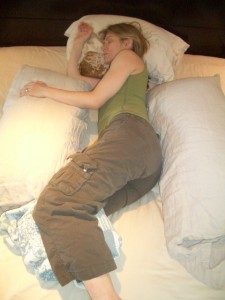
Wake up like a champ!
Now that you’ve established your simple sleep rituals, here are some new rituals to help you crawl out of bed awake, refreshed and un-grumpy!
1. Tune in to your breath
The first few moments of awakening we are still in a deeply sedated state of mind (unless your alarm clock was blaring speed metal to wake you!). Try to extend this tranquil time for 3-5 minutes by practicing a breathing meditation for a few minutes called “Bare Attention.”
Here’s how to do it: Notice that you are aware that you are waking up. Instead of opening your eyes and moving, remain perfectly still and let your mind become an “observer” of the way your body is currently breathing. There is no need to change or manipulate your breath in any way — simply watch your breath move in when it moves in, and watch your breath move out when it moves out. It’s as if you are a “breath scientist” studying the behavior of your own breath. This will help you to remain calm, aware and focused throughout your day.
2. Follow your animal instinct
Watch a cat or dog awaken, and notice how they actually tighten their whole body and then stretch while they are still stiffening their muscles everywhere. They literally ripple as they stretch! This type of stretching, called PNF or Proprioceptive Neuromuscular Facilitation, is great for people, too: It unravels and melts stiffness in the muscles and connective tissues and stimulates your cells from inside out. So, after you finish your breath work, start on what I like to call “squirm work.”
How to do it: Upon waking, channel your inner animal and imagine your body is coated in thick elastic. Press your body and limbs into the bed, sheets and blankets as if they are also made of thick elastic. Begin to move against your “opponent” (the bed-stuff) until you have wrestled yourself into a position that feels like an unnaturally “natural” shape. Encourage a deep breath into your body, and then squirm again with even more internal resistance by tightening your abdominals, buttocks, thighs and arms. It will feel as if your whole body is taking gigantic yawns. Aim to do this for 3-4 minutes.
3. Brush up to wake up
Skin brushing is a yogic cleansing technique that focuses on vigorous skin exfoliation. This is done on dry skin before a shower with a firm loofah, bath mitt or other skin brush. This brisk brushing improves circulation and gives you a lively jolt as if you’d downed an espresso.
How to do it: Step into a non-running bathtub or shower in the buff. Take a huge inhale, hold your breath and then vigorously scrub the top and bottoms of your right foot in a circular motion using a loofa, mitt, or skin brush until you can no longer hold the breath. Exhale. Inhale again, hold breath firmly, and then scrub the left foot til you need to exhale. Proceed with this invigorating breathing technique and briskly brush the remaining regions of your body in the following sequence (one breath per section):
– right calf
– left calf
– right thigh
– left thigh
– right hip/buttock
– left hip/buttock
– right hand and forearm
– left hand and forearm
– right shoulder
– left shoulder
– abdomen
– lower back
– chest
– upper back (hmm… better try some Yoga Tune Up® shoulder stretches!)
– neck
This 3-5 minute sequence will flood you with endorphins, get your heart soaring and leave your skin and soul glowing! You’ll feel like you’ve just worked out, and ready to take on the day… Let us know how this works for you!


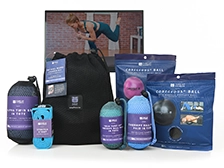
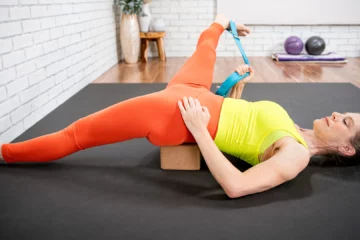
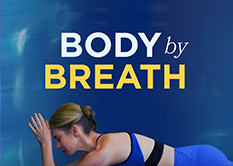
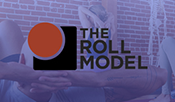
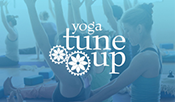


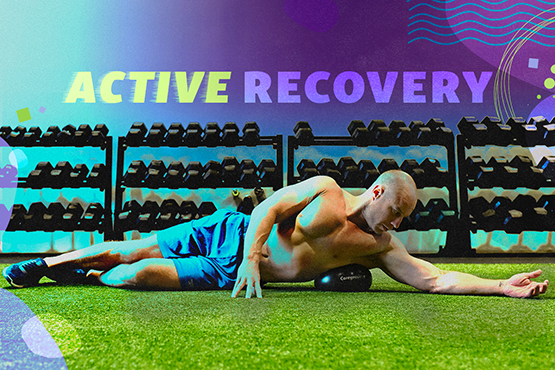
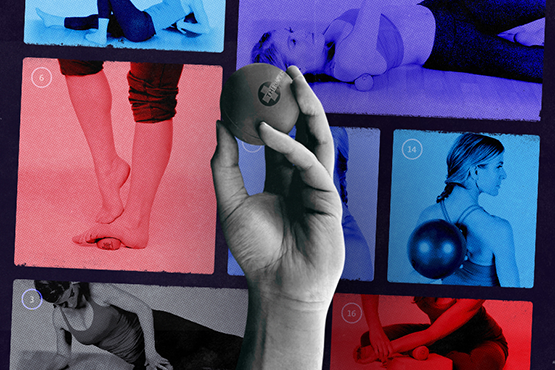
My 8 year old daughter was showing me the stretches she does each morning, and believes she is the inventor of the full body morning stretch;)Her description and example were lovely and I could tell how good it makes her feel to do this. It’s nice to hear it from a professional as well! This article also suggests taking our time to breathe and observe, to move and awaken our body sense while still in bed – sounds heavenly!
I found this blog as a link to Alex Iglecia’s about waking up more easily. I love the skin brushing sequence you list here and have been trying that in the morning as I am super-snoozer…I have such trouble waking up. I also like the contract/release that mimics how my dog and cat wake up. I looked it up because I love words and it is called pandiculation – and there is a whole science behind using this type of PNF to reset biological rhythms between sleep and awake. I do have electronics near my bed and I wonder if this is affecting my ability to wake up as well? This is great food for thought about better rest as a way to wake up more easily.
Ohhhh this opens up a brand new way or vision of this shower routine . My body feels tickelish just Reading this ? thanks
It’s amazing upon waking up if you literally get out of bed without stretching you will automatically feel stiff and aches , also I notice if upon waking I start thinking of the “what if’s “ my breathing starts to quicken and so does my heartbeat. By becoming aware and practicing a few stretches and switching the tape player in your mind to gratitude , I can become heathier in my mind and my body.
Thank you for sharing these morning routines! I set my tuneup therapy balls at the foot of my bed so I roll my feet every morning and it helps me wake up!
Wow, most of these techniques I never thought to do in the morning! I enjoy a good PNF before going to bed but I bet it would be even better in the morning. The skin brushing also sounds amazing. Next morning where I am not woken up by an infant I will definitely give that a try. Thanks Jill!
Curious to know the purpose of holding your breathe while skin brushing?! Are there health benefits or is this just a way to brush each area for a specific time period?
I am so happy to be reading this! I’m very much interested in helping myself awaken in the morning with more positive vigor and motivation and all of this makes a lot of sense. I love the idea of being a breath scientist, giving my mind something to do (that it can do that early) instead of letting it run off into all of the ‘to do’s’ for the day which can drain my energy before I’ve even begun to move! I love the Squirm work, it is so instinctual, I see my cat and children to do it. What an important exercise that can make such a difference! And thank you for reminding us of Skin brushing! It was recommended for me a long time ago for depression and bringing more blood to the heart! Yes, these techniques work, thank you!
Never thought to do such an active long PNF first thing in the morning, it is how I move my body instincualyl in the morning. My husband just pops out of bed, I keep telling him I dont think its healthy. I look forward to lengthening my stay in bed before my feet hit the ground.
I have always dreaded the morning. To the point where I don’t go to sleep because I do t want to get up. Talk about a bad combination. I love the idea of exploring my breath upon waking and can’t wait to practice my squirm worm. Thank you for the suggestions.
[…] Reposted with permission from Jill Miller’s Yoga Tune Up Blog […]
[…] with waking up without an alarm by creating a strong mental focus for yourself known as a sankalpah, or intention. […]
This inspires me to be more aware of my waking process. I have a nighttime ritual and a morning ritual, but there is a gap between the waking and the ritual, which has room for a little more conscious awareness.
I find it so important to wake up on a positive note, fresh, alive and ready to go. I mimic an animal’s stretching and scrub myself silly. I even scrub my face because I like the feeling, but I don’t recommend it for everyone (but I say you gotta try it once in your life :). As for the BARE ATTENTION breathing. Breathing to me has helped me in so many ways throughout my life (during stress, fatigue, competition, before going to bed, etc) I never thought about doing intentional breathing upon waking. Tomorrow, I will do it! Especially since I am at the Kripalu Centre right now and have all the time in the world. Thanks Jill!
Thanks! O yes evening and morning rituals are really good, especially up here in Scandinavia this time of year….. Body is really tamasic while waking up, find shower really helpful to awaken the body and will try the rest of the tips tomorrow (with à little help from my Swedish/English dictionary:) also Before I go to sleep I like to have à moment of cleaning my mind from the day. What has been positive, negative, uncomfortable, challenging, joyful etc.. What have I learned on my spiritual path, often just small little things or moments, meetings etc. Or / and just bless à moment in gratitude being you, find something u are really grateful for. 🙂 Good Night!/ God natt! Om Shanti
Thank you for the great info I will start tomorrow.
Namaste
I am so excited to try all of these rituals (especially the skin brushing) – I have the hardest time waking up in the morning and perhaps this will revolutionize my life!
How fabulous – Loofah for Life! I can’t wait to try this tomorrow. Especially in the winter, when the low-grade skin itch sets in. Not only must it feel fantastic, but it must bring a heavenly glow to the epidermus/dermis. Shoot – what better way to start your morning/day, light meditation, stretches, and loofah – the only thing I’d add is a headstand, or wheel (a perfect fast track to morning perfection) – oh, and an avocado, sliced onto whole wheat toast, drizzled with olive oil, himalayan salt, and freshly ground pepper. Of special note: FRESH CO. makes a super product call SUGAR body scrub, acts as the most delicious exfoliator. Make sure to use it on your body though, and not the toast.
Well, I tried it for a week. And much to my surprise, it worked. Thanks Jill, this is really helpful.
Can’t wait for tomorrow to add squirming and skin brushing. The only thing I have to add is my most important morning ritual, my morning practice. When I miss it I feel off for the rest of the day. Still, telling everyone about the fuzz factor we way on that cadaver, last month. Who wouldn’t move in the morning after seeing that?????
I love the idea of the dry scrub with a loofa. Waking up slow and with attention is a practice I will tell my husband about too! Thanks!!!
Skin brushing. …what a great idea to invite into your daily routine. I’ve done it at the spa-why not bring that home?! Besides, .your largest organ works so hard for you…about time it got some lovin’!
These are fantastic tips. I am so guilty of keeping the cellphone bedside. I often check email as soon as I wake up, while I’m still under the covers. One bad email can really throw off the morning! I can’t wait to try the skin brushing technique. It sounds very soothing. I always take a few minutes to stretch first thing in the morning. It helps get the blood pumping and the act of moving alone makes me feel as though I’m preparing for the day. I love Sylvia’s suggestion of ending the shower with a blast of cold water. That will most definitely wake you up, and I’ve been told by hair stylists that it helps to seal the hair cuticles as well, it’s just great all around!
I’ve never been so excited to wake up for a regular Monday morning workday! I’m trying these tips tonight and I’m excited to see how they work.
I wake up between 5:30-6 for work each day. I find it’s easy for me to wake up in summer, but very difficult to get out of bed in winter because it’s stlil dark out. Do you have any seasonal tips for waking up in the dark?
I’ll be trying these as well (Jen we can talk about them in training ;)) I will still have my cell phone close by for now – guess i need to buy an alarm clock… The breathing exercises are immediately accessible and will be tried out in just a few hours. Thank you, Jill!
I am curious if there’s ever a point where routine, and consistently getting adequate amounts of sleep would diminish the need for an alarm clock at all.
My daily routines just aren’t working. I feel lethargic in the mornings and I usually wake up and drag myself into the shower after a night of charging my cell phone next to my bed and waking up at 2am to drink water. These are great tip that I will be bringing into my life starting tonight. Thank you for the advice!
Thank you Jill for the wonderful tips! I would love to try them all, especially the squirming and stretching in bed in the morning. I normally have my alarm go off at 6:30 AM and I jump right out of bed, feeling stressed and exhausted. Having studied Ayurveda, I know that restful sleep is super important for having a healthy body and mind, and establishing a good bedtime routine is essential for having a good night sleep.
Something that I would like to add is that I scrub my tongue before bed and first thing in the morning to get rid of dead cells and bad breath. I also use the neti pot pretty frequently, especially in the winter, as it clears up my airway from nasty mucus and allows me to breathe more freely throughout the night and during the day.
I agree with Jill that dry brushing is an extraordinary technique that will not only leave your body feeling invigorated but will give you an amazing glow and very healthy skin. I do it every morning and absolutely love it!
…and one last thing, for those of you who are brave, you can try ending your showers with cold water in the morning – it wakes you up and gives your skin amazing tone. An Ayurvedic teacher once said that ending your showers with cold water is better for your skin than the most expensive skin lotions out there. Definitely worth a try 🙂
Update: After a particularly stressful day yesterday and tossing and turning for over an hour last night, I tried the above recommendations to try and a) get some much-needed sleep and b) wake up refreshed. I found that the proper placement of the pillows between my knees and under my neck did help with spine alingment AND actually solved my problem of always having really cold feet throughout the night. i guess the adjustment to my spine made my circulation better and I felt a marked improvement on the cold front. Once i finally got to sleep, I did sleep soundly. Unfortunately, I was only able to get about 3 hours of shut-eye, so I was counting on the “Brush Up to Wake Up” recommendation to save me this morning. Surprisingly (and thankfully), it actually worked! I walked into the shower like a zombie and came out wide awake, skin all fresh ‘n tingly. Hopefully that revived feeling will stick with me throughout the day, but if not, I’m just glad it got me up and going this morning! Thanks Jill!
i’ve never heard of skin brushing – but i’m going to give this a whirl! i can always use an extra boost in the morning to wake up as well as a reminder to start my pranayama first thing in the morning. seeing that i need that reminder basically every pose during my vinyasa class, this will start my day off perfectly. i can’t wait to try this!
I will definitely give this a try! It’s so easy to to start your day on the wrong foot when jolted from sleep by the not so peaceful man-made sounds of the outside world. I’ve noticed that something as simple as setting my alarm clock so that I wake up to music instead of the annoying (and quite frankly, unsettling) noise of a buzzer makes all the difference in how the rest of my day goes. I figure, since we now spend the majority of our lives in a sympathetic nervous system (fight or flight)- dominant mode and almost completely re-hardwired to respond to overstiumuation from technology and stress, the calmer the setting for the experience of reentry to that waking life, the better! I’d be interested to see how the methods listed above can help keep me in the parasympathetic nervous system mode longer and what benefits I’ll reap as a result of making this a part of my morning routine.
Sleep! I love a nice warm cozy bed for some good sleep! (all thoses pillows looked great). Thanks for the sleepy time tips. I somethings have a hard time getting to sleep I will work with the breath. Thanks Jill.
I’m a loofah queen, I love to scrub. I have never done a dry scrub, sounds very healthy. I will put it on my me time ritual. In addition I might add the cold water.
whoa jill, the exfoliating with pranayama is wild. how did you ever come up with this? but it makes sense sense breath suspension after the inhale and exfoliatation are both stimulating for the nervous system, helping to wake us up and then i guess if you’re into kundalini yoga, you can follow it up with a cold shower, brrr…
I tried the skin brushing this morning. My balance isn’t fully awake first thing in the morning so it was a little precarious brushing the feet (being fully awake now I realize I could have sat on the edge of the tub instead of standing on one foot at a time 🙂 .
The breath retention seemed like it would never end trying to balance on one foot and brush in circular motions. Once I got to the thighs my coordination reversed– it felt great thighs and upwards so I was forgetting to exhale until my body forced me to cough and gasp for breath. Good first try, clearly I need a some refinement or to wake up just a little more b/f trying multitask.
I actually love the picture on this blog because I also sleep with a pillow between my legs specially when I have an ache on my hip or back and that seems to really help keeping my spine in alignment as well as when Iam ready to get up from the bed I get up as I was getting up from savasana I find this to be more forgiving to the spine.
I’ve been doing my own version of the dog ripple, and often right next to my dog on the floor…I love to ‘down-dog’ with him! Spending more time with acknowledging my breath and spending more time with it sounds luxurious and may require setting the alarm a bit earlier, as I’m usually out the door running. I think the added minutes will be well worth it. Melting the fuzz always feels better. The brushing technique is something I used to do until my husband began using the dry brush as a wet scrub brush, someone who hasn’t caught on to all these wild and unusual hygiene habits. I will reclaim my brush and try your breathing method, thank you!
I too try to mimic my little dogs before going to sleep and upon rising. I will try wrestling a bit with the sheets in the morning and observing my breath. It is helpful for me to start the day with an affirmation before I set my feet on the ground. Thank for you for the information on body brushing, a little more invigoration with out caffeine sound nice.
What beautiful routines for preparing for sleep and awakening to greet a new day.
Very nice… I’ve used the observing your breath technique and found that I was also observing my thoughts before I opened my eyes to the day. It was great to be able to ward off some uneccessary negativity that was in my mind… and this truly helped me to have a more possitive outlook upon getting out of bed. Sometimes stray thoughts arise that need to be “brushed away too!” I will certainly try the body brushing. Thank you!! 🙂
[…] Reposted with permission from Jill Miller’s Yoga Tune Up Blog […]
I always give myself plenty of time to wake up due to the keen observation of my kitties. I’ve never seen my kitties jump up to an alarm and hit brew on the coffee pot. I think it’s essential to do the big yawn and ‘cat’ pose with a little downward ‘dog’ before beginning the day, thereby avoiding getting up on the ‘wrong’ side of the bed. I’ve also heard it said that a yogi will pay attention to the breath and after determining which nostril is clearer, will turn to that side and get out of bed on the same side. Maybe that’s getting out on the right side of the bed.
This is great Jill thanks for posting! I am going to make a commitment to try 1 or at least all of these suggestions not only before bed but in the morning as well. I had to laugh when you made mention to following your animal instinct. My bulldog Meatball sleeps with me and in the morning or after a long nap, he does just that – stiffens his muscles while stretching them along with a huge breathe. It’s quite funny to watch but without a doubt he does this everytime he wakes up so it’s gotta be good for him!
Love the idea of allowing myself to stay in bed a few more minutes after waking up and observing my breath. This sets a more relaxing tone for the rest of your day. Thanks!
Starting the day with a meditative way of waking up is a great idea i cant wait to wake up and try this sequence. Also the skin brushing is a technique ive been using for about a year and is great for the exfoliation process its very interesting how the breaths are incorporated cant wait to try this part of it out thanks for the post!
As many people I have trouble waking up in the morning and this seems like a great thing to try. Can’t wait to give it a go, especially waking up and starting the day with a meditation, staying in bed for a few minutes awake with the mind clear but alert.
I have eczema and other skin sensitivities. Not sure it’s such a good idea to scrub this much. What would you recommend?
Great blog, Jill.
So much depends on how we start our day so paying attention to those first precious moments can create a cascade of good intention for the rest of the day. Too often we rush and go out to meet our obligations to others but by taking back those first minutes of the day and claiming them for our own can allow you to be present to yourself and your life in a whole new way. You can start to steer the day the way you want it to go.
Also tying in the breath with the body ritual is powerful stuff. I like the idea of the moving meditation and pranayama and playfulness of the body brushing and the animalizing. Fun.
I love this! I always have trouble getting up in the morning. I really like the idea of “being aware that I am waking up” rather than forcing my body up. This sounds like a good transition out of bed in the morning.
I started the awakening process after going to a Buddhist teacher that recommended it. He said it’s connecting with the morning dew of the self. The newness and clarity we have first thing in the morning is not comparable to other times.
I love watching my dog and cat ripple! I think my kids have their own version of this too. I’ll be watching them in the morning.
I am a Waldorf Early Childhood teacher and have used the brushing technique on young children who have trouble knowing where they begin and end. It’s used in occupational therapy and I was taught to always brush down started on highest point and ending with lowest to the ground. It’s been a wonderful tool and I always thought it would be therapeutic as a self practice.
seems like a great way to wake up. i feel like maybe adding uddiyana bandha to clean the internal organs could be useful too!
Definitely something I’m going to have to try. Some habits I already have, (turning off the computer and other related devices, brushing a flossing my teeth, drinking water so I don’t wake up dehydrated). I have also admired the efficiency of my doggies as they stretch in the morning. I’m new to the skin brushing. I look forward to trying that technique!
I started a much needed morning ritual today. Took time to stretch out the fuzz, kept my eyes closed and observed my breath. Upon climbing out of bed my usual routine to drink a large water with lemon. Headed out for an hour long walk , arrived home feeling vibrant to start my day. Looking forward to the skin brushing 🙂
Hi Jill, I have yet to do the skin brushing omy gosh i may brush my tan off ha ha. Seriously looks like a good idea I think the key though is the breath, I want to experiment with that, try one day with the breath one day with out and get back to you surely their will be a difference – Wondering why you start with the feet and work up? Yes it is good to have the balnce of a yogi and the ‘reach’ of a ytu yogi to get all those forgotten places! I wanted to add a beneifit to this – when ever we do ‘anything’ to our entire body we check out our body, skin, changes ect… it’s so easy to jump into the shower and do the same old same – supriseing to see what changes can happen if the last time you looked at everything 🙂 Yea we need to pay attention to our pet’s, their stretching is so different than ours it’s slowed down for sure didn’t know that was a type of PNF, this will take practise yes. Does this type of streching help with the “fuzz”? Well will repost after a few experiments with the streaching and the brushing – Already have the tooth brushing down and the water – thanks Orlanda he he.
The older I get, the more I want to do. The more I want to do, the later I stay up to fit it all in. Often the midnight oil is burning. Too bad I didn’t take advantage of my brain when I was younger : ) However ….. I have done some reading about sleep and how much sleep we need. Some information says no less than 6 … but no more than 8. Others say get 8 – 9 hours sleep. Some say, the older you get the less sleep you need. I wonder what the right answer really is? Apparently there is alot that goes on in the body from 10pm – 12am, before we go into deep sleep and if we miss that we miss a big part of healing. I’m going to try body brushing (first brush the teeth) …. then warm water for the digestive system (my fav – green tea). Hey Eva – all about “me” ….. is definetly A-O-K !!!
hah, I will try this. Luckily, tomorrow is Saturday, I can just make the whole day about – well?? – me. All in the name of learning. Thanks guys, hope to see you soon.
Now that is how everyone should wake up. If I can make a couple more suggestions. Upon awakening brush your teach. While sleeping bacteria has had an opportunity to populate our mouth and we really do not want this bacteria in our bodies. After you have done this have a great big glass of water because at this point we are definitely dehydrated. Every time we exhale in the middle of the night we let out a little mist and by the morning we are dried out especially depending on what we had for dinner the night before.
Good luck with it all…Orlando